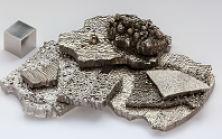
The metals industry has asked Echa for more time to address concerns about specific concentration limits in the proposed classification of cobalt metal as a category 1B carcinogen.
Echa’s Risk Assessment Committee (Rac) adopted an opinion last year for the harmonised classification and labelling (CLH) of cobalt metal for all routes of exposure with a specific concentration limit (SCL) of 0.01% w/w.
In a document shared at the meeting of the Competent Authorities for REACH and CLP (Caracal) on 12 June, industry association body Eurometaux questioned the “appropriateness” of the methodology used to calculate the carcinogenic potency and generate the SCL.
Referred to in Echa’s classification, labelling and packaging (CLP) guidance, ‘T25’ is a tool to determine the carcinogenic potency of substances by using comparison with a database of organic substances that are known oral carcinogens. By this approach, Rac calculated the carcinogenic potency of cobalt metal as “high”.
But Eurometaux questioned the method’s suitability for substances generating local cancers via inhalation, and also more specifically, for inorganic metals.
It asked Echa for more time to evaluate these concerns and, if needed, to review the methodology for inorganics.
‘Large impacts’
In a paper submitted to the European Commission in May, and circulated at Caracal, the Cobalt Institute also asked for more time, saying that the proposed 0.01% SCL will lead to “potential large” impacts for both industry and society.
These include:
- unintended consequences for the circular economy from reduced re-use of several final slag-related materials and for the high recycling rate of steel scrap;
- the unintentional presence of cobalt above the proposed 0.01% SCL in some materials, could have indirect impacts on high value supply chains (eg for nickel and stainless steel); and
- impacts on competitiveness by imposing direct costs of compliance across many EU sectors that would not affect non-EU firms.
The use of cobalt metal is “especially crucial” as a precursor in the manufacture of chemicals for batteries for various portable consumer goods, as well as the emerging market for electric vehicles, the institute said. Some uses, it said, would be restricted despite REACH dossiers showing safe use.
The institute recommended the adoption of the generic concentration limit (GCL) for carcinogenicity of 0.1% rather than the SCL of 0.01%, as this would “mitigate most of the impacts”. It could be used “at least as an interim measure”, while the SCL methodological aspects on potency, bioavailability and all routes are resolved.
Review
Echa discussed the industry reaction at the Caracal meeting, and concluded that while the potency categories based on T25 “are indeed simplistic”, they could not be regarded as “wrong per se”.
Rac recognised that some aspects decreased the concern of high potency carcinogenicity of cobalt, but these were not sufficient to move it to a lower potency group, the agency said. Most carcinogens would normally fall into the medium potency range, it added.
However, Echa said that setting up an expert meeting to discuss and review the methodology for deriving SCLs for carcinogens “would be of interest”. It added that there should be careful consideration of the best framework, because the review could result in an update of the CLP Guidance.
Eurometaux told Chemical Watch it would welcome a temporary GCL for cobalt metal “to allow the expert group to clarify whether the concerns raised above are justified or not”. The GCL could then be reviewed according to the outcomes of the expert group discussions.
The industry body has launched a review of the substances classified as category 1 carcinogen based on inhalation data in animals. It is asking the data holders to “review and/or to calculate the T25 potency” of these to provide a first overview of the applicability of the method. This work will be shared with authorities and stakeholders after the summer.
In another Caracal paper, Germany’s environment ministry and the Federal Institute for Occupational Safety and Health (Baua) said it supported an update of the methodology, but raised concerns over how long a re-evaluation of the T25 method concerning inhalation of inorganic materials would take.
“We foresee that appropriate data need to be gathered and evaluated and suggest that also the toxicological expertise from Rac is included in the evaluation process of the new method. Therefore the procedure and scheduling to implement the SCL needs to be clarified.”
